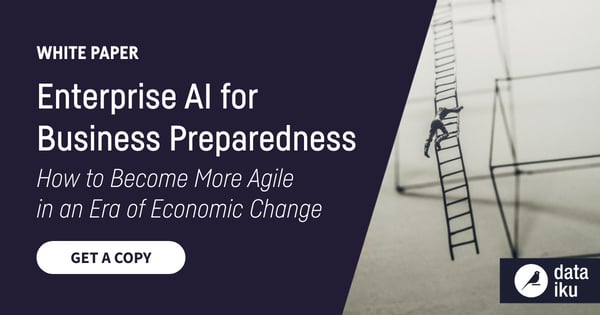According to Forbes, enterprises increased AI spending by 62% last year. However, those AI initiatives have remained tangential to many companies’ central operations, viewed more as an experiment than an indispensable organizational asset. In the second half of 2020 and beyond, this paradigm will shift, and the move to Enterprise AI will become essential for survival - here are four ways to leverage AI to become more agile in a post-pandemic world.

Optimization
More and more businesses are leveraging Enterprise AI to find areas of optimization (i.e., where the business can do more with less), as these use cases offer clear business objectives and tangible return on investment (ROI). Every organization, no matter what industry, has areas that can be optimized by AI processes. For example:
- Optimizing marketing spend with machine learning-powered attribution for hyper-personalization.
- Using machine learning to consider factors like weather, traffic, and a myriad of other constantly-shifting data sources to optimize workforce allocation.
- Moving toward machine learning-powered predictive maintenance to decrease downtime, increase quality, and improve scheduling.
Acceleration
AI use cases that accelerate the organization’s ability to execute on critical business functions are also optimal during periods of economic change. More than ever before, given the current economic climate, organizations must prioritize use cases that can start delivering results in a matter of weeks, not months or years.
Successfully prioritizing time-to-value involves a combination of choosing the right use cases (i.e., large enough for big impact, but not so expansive that they’ll be slow to get buy-in and implement) and also the right tools that help reduce friction and repetition on the path to Enterprise AI. Data science, machine learning, and AI platforms (like Dataiku) provide this experience, reducing the time it takes to connect to and clean data, create machine learning models, and deploy them to production.
Reuse
It would be naïve to ignore the fact that data science, machine learning, and AI initiatives represent a cost of their own. How, in a time where cost optimization is more critical than ever, can businesses — whether just getting started or looking to improve efficiency — manage and justify the cost of AI itself?
Reuse is the simple concept of avoiding rework in AI projects, from small details (like code snippets that can be shared to speed up data preparation) to the macro level (like ensuring two data scientists from different parts of the company aren’t working on the same project). Capitalization in Enterprise AI takes reuse to another level — it’s about sharing the cost incurred from an initial AI project (most commonly the cost of finding, cleaning, and preparing data) across other projects, resulting in many use cases for the price of one, so to speak.
Addressing Model Drift
Organizations often need to reframe data science projects quickly during turbulent times, as many of the assumptions underlying existing machine learning projects are no longer valid. Some key questions to answer for businesses that have models in production during periods of rapid change are:
- Have the business needs related to the models changed given the circumstances?
- Has the availability, reliability, and relevance of input data changed? If so, can new data sources be more relevant and better connected to the prediction targets?
- Is the granularity of the predictions or of the models (e.g., the time horizon for forecasts) still adequate?
- Should the predictions be consumed in a different manner during a volatile period? For example, if the predictions used to be directly used by a larger automated system, should a human expert be added in the loop?





